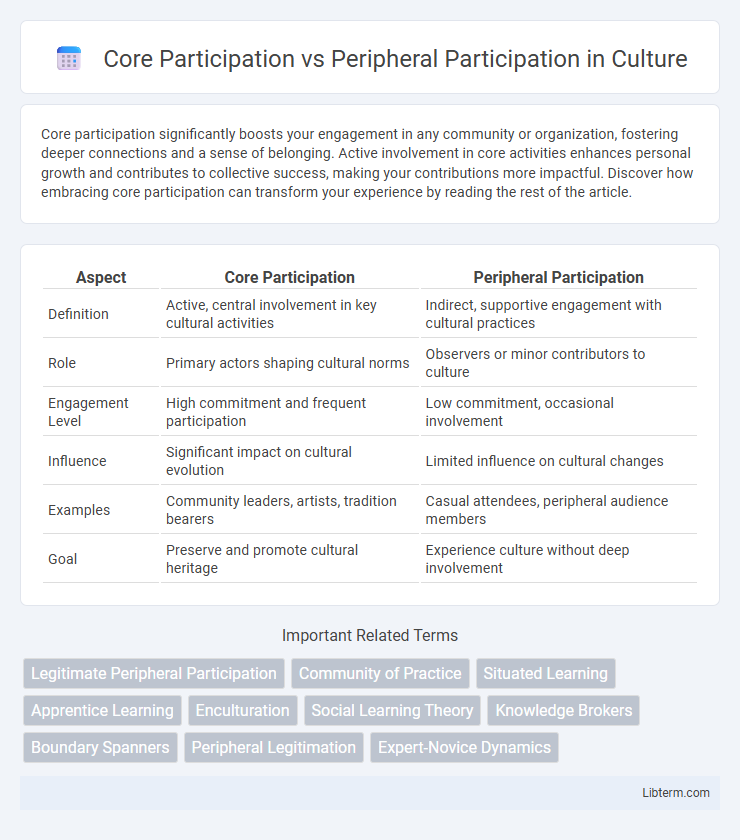Core participation significantly boosts your engagement in any community or organization, fostering deeper connections and a sense of belonging. Active involvement in core activities enhances personal growth and contributes to collective success, making your contributions more impactful. Discover how embracing core participation can transform your experience by reading the rest of the article.
Table of Comparison
| Aspect | Core Participation | Peripheral Participation |
|---|---|---|
| Definition | Active, central involvement in key cultural activities | Indirect, supportive engagement with cultural practices |
| Role | Primary actors shaping cultural norms | Observers or minor contributors to culture |
| Engagement Level | High commitment and frequent participation | Low commitment, occasional involvement |
| Influence | Significant impact on cultural evolution | Limited influence on cultural changes |
| Examples | Community leaders, artists, tradition bearers | Casual attendees, peripheral audience members |
| Goal | Preserve and promote cultural heritage | Experience culture without deep involvement |
Introduction to Core and Peripheral Participation
Core participation involves active engagement in central tasks and decision-making processes within a group or organization, directly influencing outcomes and driving progress. Peripheral participation refers to more passive or observational involvement, where individuals contribute indirectly or gradually gain experience without being at the forefront of activities. Understanding the distinction between core and peripheral roles helps organizations optimize collaboration, skill development, and integration of new members.
Defining Core Participation
Core participation refers to the active and consistent involvement of individuals in the central activities and decision-making processes within a community or organization. It encompasses roles that are critical for shaping norms, driving initiatives, and sustaining the core functions that uphold the group's purpose. Defining core participation involves identifying key members who influence strategies, maintain institutional knowledge, and foster collaboration at the heart of collective efforts.
Understanding Peripheral Participation
Peripheral participation allows newcomers to engage in a community or practice at a low-risk, observational level, gradually building skills and knowledge before taking on more central roles. This process supports learning through legitimate peripheral participation, where individuals gain insight into group norms, values, and practices while contributing in less critical tasks. Understanding peripheral participation is essential for fostering inclusive environments that encourage growth and full integration into core activities.
Key Differences Between Core and Peripheral Participation
Core participation involves individuals actively engaging in primary activities critical to an organization's mission, often holding central roles with significant responsibilities. Peripheral participation refers to more occasional or supportive involvement, where individuals contribute on the margins without direct influence on core decision-making or major tasks. The key differences lie in the level of engagement, influence, and commitment, with core participants being deeply embedded and peripheral participants maintaining looser, more flexible connections.
Roles and Responsibilities in Core Participation
Core participation involves active engagement in primary roles and responsibilities essential to an organization's mission, including decision-making, strategy development, and key operational tasks. Individuals in core roles are accountable for driving projects, managing teams, and ensuring alignment with business objectives. Their responsibilities demand consistent contribution, expertise application, and leadership in critical activities that influence overall success.
Impact of Peripheral Participation on Community Dynamics
Peripheral participation fosters inclusive community dynamics by enabling newcomers to observe and gradually engage without full commitment, which enriches knowledge exchange and sustains community growth. This form of engagement allows members on the edges to contribute diverse perspectives and adapt at their own pace, strengthening social cohesion and innovation within the community. Over time, peripheral participants often transition into core members, enhancing leadership diversity and resilience of the community structure.
Benefits of Engaging Core Participants
Engaging core participants drives higher collaboration efficiency by ensuring involvement of highly committed and knowledgeable individuals who contribute to innovation and problem-solving within a group. Core participants enhance trust and communication frequency, fostering a stronger sense of community and facilitating knowledge sharing. This active engagement leads to sustained motivation and improved outcomes, reinforcing the group's overall performance and resilience.
Challenges Faced by Peripheral Participants
Peripheral participants often struggle with limited access to key resources and decision-making processes, hindering their ability to influence core group activities. Social isolation and lack of recognition contribute to diminished motivation and engagement, affecting collaboration effectiveness. Overcoming communication barriers and building trust with core members remain significant challenges for peripheral participants seeking integration.
Strategies to Foster Movement from Peripheral to Core Participation
Organizations can foster movement from peripheral to core participation by implementing targeted engagement strategies such as personalized onboarding programs, mentorship opportunities, and skill-building workshops that align with members' interests and goals. Providing clear pathways for increased responsibility and recognition encourages deeper involvement and commitment within community roles. Utilizing data-driven feedback mechanisms helps identify barriers to core participation and tailor interventions that support progressive integration.
Conclusion: Balancing Core and Peripheral Participation for Success
Balancing core participation, which drives direct engagement and leadership, with peripheral participation, offering observational learning and gradual integration, is essential for sustainable success in organizational and community settings. Integrating both forms fosters comprehensive involvement, enhances skill development, and strengthens social connections, ultimately promoting long-term commitment and productivity. Strategic management of participation ensures that members transition smoothly from peripheral to core roles, maximizing collective impact and growth.
Core Participation Infographic

 libterm.com
libterm.com